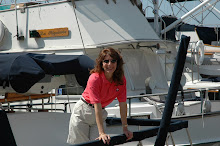BIRDS OF A FEATHER
By Barb Hansen
November 2010
The other day I watched some warblers twit about the shrubbery and I was reminded of an enduring scientific certainty: We are animals. I mean that in a nice way, of course.
It’s easy to forget this while sipping merlot and emailing friends, but it’s true. Ask anybody. We belong to the kingdom of animalia, the order of primates, the genus of homo, the species of sapiens, the advanced species of wine lovers and the super-duper family of sailors. (The last two are just theories at this point. Mine, actually.)
I also believe that like warblers we humans are hard-wired to do certain things like, for example, migrate to Florida during the winter months. However, because we have advanced brains and central heat, many in the kingdom of animalia ignore those signals. And that is such a shame, because those who live in cold climates could be having so much fun outside in the sunshine and stay warm, too. Not listening to those health signals, I suspect, is one of the primary causes of the growing pandemic that the researchers call Seasonal Affective Disorder (SAD).
Warblers are hard-wired to fly to Southwest Florida in September and depart for Central America in November. We’ll miss them, of course, but it’s okay because they are listening to their inner selves and doing what they are supposed to do. Anyway, more snowbirds are on the way. Flocks of white pelicans from Canada will soon be floating in sheltered coves, diving on thick schools of minnows and taking graceful winged exercise together. Belted kingfishers will whistle and zoom through mangrove passages. Here and there a loon from the land of frozen lakes (Midwest and Canada) will pop to the surface with a fish wiggling in its beak. Our resident bald eagles and hawks always invite their cousins to visit from up north and they all come.
None of these snowbirds to the best of modern scientific knowledge suffers from SAD. Nor is there a documented case of SAD among our permanent populations of herons, ibises, egrets, willets and bitterns. All of these happy creatures are on display in the winter months to watchful sailors. Vic and I especially like to cruise the skinny backbay waters of Pine Island Sound because we can observe so many birds doing what their instincts tell them to do.
As scientific observers of the barrier islands of biodiversity at certain times of the year we hypothesize that we are also obeying silent neural instructions up to and including the part when we put the cork back into the tall, brown bottle with the dark red fluid. When summer returns to Florida each year Vic and I, still obeying said neural system signals, break open the chardonnay and migrate to cooler climes to visit relatives in New York City, Vermont, Indiana and other points north.
As a young history student in Indiana I remember learning about and feeling so sorry for the native Americans of the upper Midwest who had to try to stay warm through those brutal winters wearing only those meager garments. But I later learned they didn’t stay there in the winter. They went south, following the sun, eating fresh fish and going where the weather suited their clothes. They were the original Florida snowbirds of the homo sapiens persuasion.
Vic and I and the visitor’s bureau warmly invite you and yours to do what warblers, ruby throated hummingbirds and all birds of a certain feather do enthusiastically when the temperature drops -- vacation in Florida.
People, listen to your inner selves. The heating bills that arrive at your home this fall and winter will remind you of that.


0 Comments:
Post a Comment
<< Home